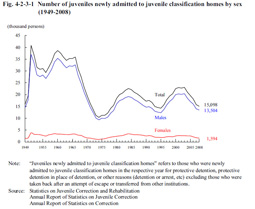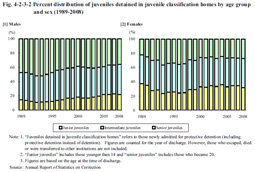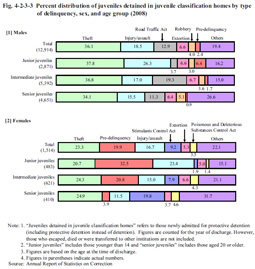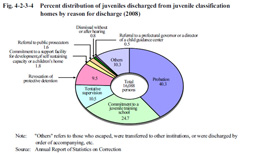| Previous Next Index Image Index Year Selection | |
|
|
1 Admission and discharge (1) Number of juveniles newly admitted to juvenile classification homesFig. 4-2-3-1 shows the number of juveniles newly admitted to juvenile classification homes from 1949. This refers to those newly admitted in a respective year for protective detention, protective detention in place of detention, or other reason (detention, arrest, etc.), equivalent to the “number of newly admitted juveniles in juvenile classification homes” in the Annual Report of Statistics on Correction. The number increased from 1996 and reached the largest since 1970 in 2003, but then continued to decrease every year from 2004 through to 2008 (See Appendix 4-11). In 2008, 85.9% were admitted for protective detention and 10.4% for protective detention in place of detention. Some were also admitted for detention or detention for expert examinations, etc. (Source: Annual Report of Statistics on Correction). Fig. 4-2-3-1 Number of juveniles newly admitted to juvenile classification homes by sex (1949–2008) (2) Characteristics of juveniles detained in juvenile classification homesFig. 4-2-3-2 shows the percent distribution of juveniles detained in juvenile classification homes (refers to those newly admitted for protective detention or protective detention instead of detention but not including those who escaped, died or were transferred to other institutions. The number of juvenile inmates is counted on the year of discharge, and is equivalent to “newly admitted juveniles in juvenile classification homes” in the Annual Report of Statistics on Correction; hereinafter the same in this section and Section 7) by age group and sex over the last 20 years. Among males the proportion of junior juveniles has generally been on a rising trend. The proportion of those detained at a young age was higher for females when compared with males. Fig. 4-2-3-2 Percent distribution of juveniles detained in juvenile classification homes by age group and sex (1989–2008) Fig. 4-2-3-3 shows the percent distribution of juveniles detained in juvenile classification homes by type of delinquency, sex, and age group in 2008.For males the proportion for theft was the highest across all age groups, followed by injury/assault, Road Traffic Act violations, and extortion, etc. whereas the proportion for Stimulants Control Act violations was remarkably low (the highest proportion was 1.8% of senior juveniles). For females, as the age of the group rose, the proportion for pre-delinquency and injury/assault declined, while that of Stimulants Control Act violations rose. Fig. 4-2-3-3 Percent distribution of juveniles detained in juvenile classification homes by type of delinquency, sex, and age group (2008) (3) Reason for dischargeFig. 4-2-3-4 shows the percent distribution of juveniles discharged from juvenile classification homes by reason for discharge in 2008. Fig. 4-2-3-4 Percent distribution of juveniles discharged from juvenile classification homes by reason for discharge (2008) |



